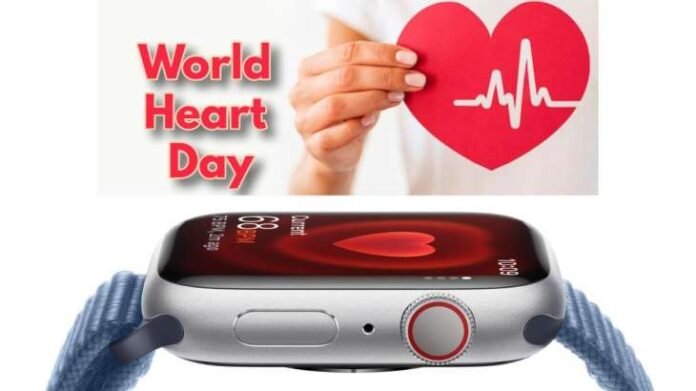The World Heart Federation is urging people to prioritize heart health on World Heart Day. The Apple Watch Series 9 monitors heart rates and alerts users to abnormally high or low rates, a crucial early warning sign for hidden heart problems.
The World Heart Federation is urging people all across the world to prioritize heart health on the occasion of World Heart Day. The Apple Watch, which is renowned for its capacity to warn users of potential indicators of atrial fibrillation (AFib), a dangerous heart ailment, is one effective instrument in doing this. The Apple Watch Series 9 monitors heart rates in the background, just like earlier models, and alerts users to abnormally high or low rates. This feature can act as a crucial early warning sign for hidden heart problems, urging people to seek additional testing.
A notification is sent out whenever a user’s heart rate rises above 120 or drops below 40 beats per minute while they appear to be inactive for 10 minutes. Additionally, users have the option to modify these levels or completely turn off notifications. The Health app on an iPhone makes it simple to get all heart rate notifications and time-stamped data.
The Apple Watch’s capability to periodically check for abnormal cardiac rhythms is yet another impressive feature. This feature can aid in the detection of probable AFib, a condition when the heart’s upper and lower chambers become out of sync. While some people may not exhibit any symptoms at all, others may feel breathless, fatigued, or have a racing heart.
The Apple Watch’s optical heart sensor is used to analyze the pulse wave at the wrist as part of the irregular rhythm notification feature. The system can detect abnormal rhythms suggestive of AFib by observing differences in beat-to-beat intervals during rest. Users are alerted if these trends continue, and the information is entered into the Health app.
The ECG app is a helpful resource for users who are experiencing symptoms like rapid or irregular heartbeats. This app records a single-lead ECG using the electrical cardiac sensor included into the watch. Results may show an AFib with a fast heart rate, a normal cardiac rhythm, or an unreliable or subpar recording. Any associated symptoms, such as weariness or dizziness, are requested from users. The recorded data can be saved as a PDF for simple communication with medical specialists, including with the waveform, outcomes, and symptom information.
The Cardio Fitness feature of the Apple Watch, which calculates VO2 Max—a measure of the body’s capacity to absorb oxygen during exercise—is another new feature. Experts in heart health regard this statistic as a potent indicator of general wellbeing. Users can choose to be notified if their classification decreases to “low,” which may indicate a major risk for long-term health problems. Fortunately, gains can be achieved by consistent, demanding exercise, with easy tracking of results.
The AFib History, which gives users an estimate of how frequently their heart displays signals of AFib, is one ground-breaking addition. This information is essential because studies show a connection between it and symptom intensity, quality of life, and complication risk. Additionally, AFib History gives users the ability to monitor lifestyle elements including sleep, exercise, and weight, providing important insights into the development of the condition.
Conclusion
The World Heart Federation is urging people worldwide to prioritize heart health on World Heart Day. The Apple Watch, known for its ability to warn users of potential indicators of atrial fibrillation (AFib), is one effective tool in doing so. The Apple Watch Series 9 monitors heart rates in the background and alerts users to abnormally high or low rates, acting as an early warning sign for hidden heart problems. Users can modify these levels or turn off notifications. The Health app on an iPhone makes it simple to get all heart rate notifications and time-stamped data.
The Apple Watch’s irregular rhythm notification feature uses the optical heart sensor to analyze pulse wave at the wrist, detecting abnormal rhythms suggestive of AFib. The ECG app records a single-lead ECG using the electrical cardiac sensor included into the watch, and the recorded data can be saved as a PDF for communication with medical specialists.
The Cardio Fitness feature calculates VO2 Max, a measure of the body’s capacity to absorb oxygen during exercise, as a potent indicator of general wellbeing. Users can choose to be notified if their classification decreases to “low,” which may indicate a major risk for long-term health problems. The AFib History feature provides users with an estimate of how frequently their heart displays AFib signals, providing insights into the development of the condition.



